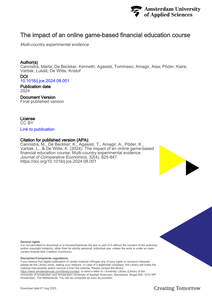BackgroundConfounding bias is a common concern in epidemiological research. Its presence is often determined by comparing exposure effects between univariable- and multivariable regression models, using an arbitrary threshold of a 10% difference to indicate confounding bias. However, many clinical researchers are not aware that the use of this change-in-estimate criterion may lead to wrong conclusions when applied to logistic regression coefficients. This is due to a statistical phenomenon called noncollapsibility, which manifests itself in logistic regression models. This paper aims to clarify the role of noncollapsibility in logistic regression and to provide guidance in determining the presence of confounding bias.MethodsA Monte Carlo simulation study was designed to uncover patterns of confounding bias and noncollapsibility effects in logistic regression. An empirical data example was used to illustrate the inability of the change-in-estimate criterion to distinguish confounding bias from noncollapsibility effects.ResultsThe simulation study showed that, depending on the sign and magnitude of the confounding bias and the noncollapsibility effect, the difference between the effect estimates from univariable- and multivariable regression models may underestimate or overestimate the magnitude of the confounding bias. Because of the noncollapsibility effect, multivariable regression analysis and inverse probability weighting provided different but valid estimates of the confounder-adjusted exposure effect. In our data example, confounding bias was underestimated by the change in estimate due to the presence of a noncollapsibility effect.ConclusionIn logistic regression, the difference between the univariable- and multivariable effect estimate might not only reflect confounding bias but also a noncollapsibility effect. Ideally, the set of confounders is determined at the study design phase and based on subject matter knowledge. To quantify confounding bias, one could compare the unadjusted exposure effect estimate and the estimate from an inverse probability weighted model.
MULTIFILE

This paper evaluates the impact of an online game-based financial education tool on students' financial literacy levels. By conducting a Randomized Controlled Trial (RCT) involving 2,220 students across four countries in a multi-country experimental setting, we demonstrate that the intervention significantly enhances students' financial literacy levels by 0.313 SD. This study contributes to the emerging academic literature concerning the evaluation of financial education interventions that incorporate learning-by-playing. The participation of students from four countries adds relevance by facilitating cross-comparison of outcomes and stimulating discussions about country-specific factors and peculiarities influencing youth financial literacy.
DOCUMENT

Although there is some evidence that total dietary antioxidant capacity (TDAC) is inversely associated with the presence of obesity, no longitudinal studies have been performed investigating the effect of TDAC on comprehensive measures of body composition over time. In this study, we included 4595 middle-aged and elderly participants from the Rotterdam Study, a population-based cohort. We estimated TDAC among these individuals by calculating a ferric reducing ability of plasma (FRAP) score based on data from food-frequency questionnaires. Body composition was assessed by means of dual X-ray absorptiometry at baseline and every subsequent 3-5 years. From these data, we calculated fat mass index (FMI), fat-free mass index (FFMI), android-to-gynoid fat ratio (AGR), body fat percentage (BF%) and body mass index (BMI). We also assessed hand grip strength at two time points and prevalence of sarcopenia at one time point in a subset of participants. Data were analyzed using linear mixed models or multinomial logistic regression models with multivariable adjustment. We found that higher FRAP score was associated with higher FFMI (0.091 kg/m2 per standard deviation (SD) higher FRAP score, 95% CI 0.031; 0.150), lower AGR (-0.028, 95% CI -0.053; -0.003), higher BMI (0.115, 95% CI 0.020; 0.209) and lower BF% (-0.223, 95% CI -0.383; -0.064) across follow-up after multivariable adjustment. FRAP score was not associated with hand grip strength or sarcopenia. Additional adjustment for adherence to dietary guidelines and exclusion of individuals with comorbid disease at baseline did not change our results. In conclusion, dietary intake of antioxidants may positively affect the amount of lean mass and overall body composition among the middle-aged and elderly.
DOCUMENT
